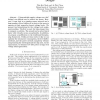101
click to vote
CAL
2004
15 years 25 days ago
2004
We compare techniques that dynamically scale the voltage of individual network links to reduce power consumption with an approach in which all links in the network are set to the s...
116
Voted
GLVLSI
2010
IEEE
15 years 1 months ago
2010
IEEE
We revisit voltage partitioning problem when the mapped voltages of functional units are predetermined. If energy consumption is estimated by formulation E = CV 2 , a published wo...
105
click to vote
SAC
2010
ACM
15 years 1 months ago
2010
ACM
Voltage islanding technique in Network-on-Chip (NoC) can significantly reduce the computational energy consumption by scaling down the voltage levels of the processing elements (P...
ISLPED
2007
ACM
15 years 2 months ago
2007
ACM
Increases in peak current draw and reductions in the operating voltages of processors continue to amplify the importance of dealing with voltage fluctuations in processors. One a...
118
click to vote
ISLPED
2007
ACM
15 years 2 months ago
2007
ACM
Dynamic voltage scaling (DVS) is known to be one of the most efficient techniques for power reduction of integrated circuits. Efficient low voltage DC-DC conversion is a key enabl...
183
click to vote
ARVLSI
2001
IEEE
15 years 4 months ago
2001
IEEE
As the operating supply voltage for commercial CMOS devices falls below 2 V, research activities are underway to develop CMOS integrated circuits that can operate at supply voltag...
118
click to vote
DAC
2010
ACM
15 years 4 months ago
2010
ACM
System optimization techniques based on dynamic voltage scaling (DVS) are widely used with the aim of reducing processor energy consumption. Inter-task DVS assigns the same voltag...
ASPDAC
2007
ACM
15 years 5 months ago
2007
ACM
Multiple supply voltage (MSV) is one of the most effective schemes to achieve low power, but most works are based on logic level. A few recent works are based on physical level but...
ASPDAC
2007
ACM
15 years 5 months ago
2007
ACM
Using multiple supply voltages on a SoC design is an efficient way to achieve low power. However, it may lead to a complex power network and a huge number of level shifters if we j...
106
click to vote
VTS
1997
IEEE
15 years 5 months ago
1997
IEEE
A stress procedure for reliability screening, SHOrt Voltage Elevation (SHOVE) test, is analyzed here. During SHOVE, test vectors are run at higher-than-normal supply voltage for a...





